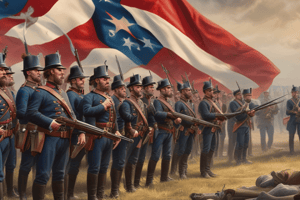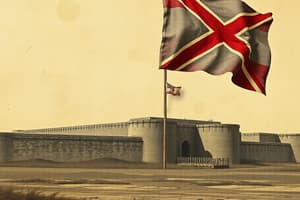Podcast
Questions and Answers
What was one of the key advantages of the Confederacy during the Civil War?
What was one of the key advantages of the Confederacy during the Civil War?
- More industrial resources
- Greater access to railroads
- Larger population
- Home field advantage (correct)
The Union had a significant advantage in industrial capacity, possessing 90% of the U.S. industrial resources.
The Union had a significant advantage in industrial capacity, possessing 90% of the U.S. industrial resources.
True (A)
How many people were in the Union compared to the Confederacy?
How many people were in the Union compared to the Confederacy?
22 million in the Union and 6 million in the Confederacy
The Union's economic strategy included issuing bonds totaling __________ in 1861.
The Union's economic strategy included issuing bonds totaling __________ in 1861.
Match the following advantages with the side that had them:
Match the following advantages with the side that had them:
What was one of the effects of the Emancipation Proclamation for the Union?
What was one of the effects of the Emancipation Proclamation for the Union?
The Confederate economy heavily relied on cotton trade.
The Confederate economy heavily relied on cotton trade.
Name one role women played on the home front during the Civil War.
Name one role women played on the home front during the Civil War.
The Union printed __________ in 'Greenbacks' during the war.
The Union printed __________ in 'Greenbacks' during the war.
Which technology was NOT a significant factor in the Civil War?
Which technology was NOT a significant factor in the Civil War?
Which battle is known as the first ironclad battle?
Which battle is known as the first ironclad battle?
Robert E. Lee led the Army of Northern Virginia during the Civil War.
Robert E. Lee led the Army of Northern Virginia during the Civil War.
What was the primary purpose of the Emancipation Proclamation?
What was the primary purpose of the Emancipation Proclamation?
The Confederate submarine that sank the USS Housatonic was known as the __________.
The Confederate submarine that sank the USS Housatonic was known as the __________.
Match the following leaders with their respective armies:
Match the following leaders with their respective armies:
During which battle did the Confederacy achieve a victory under General Beauregard?
During which battle did the Confederacy achieve a victory under General Beauregard?
Trench warfare was primarily used to advance on enemy positions.
Trench warfare was primarily used to advance on enemy positions.
What was the name of the military campaign intended to capture Richmond?
What was the name of the military campaign intended to capture Richmond?
The __________ provided a military decision that aimed to weaken the South by freeing slaves.
The __________ provided a military decision that aimed to weaken the South by freeing slaves.
What was one of the goals of Lee’s invasion of Maryland?
What was one of the goals of Lee’s invasion of Maryland?
Flashcards
Confederate Advantages in the Civil War
Confederate Advantages in the Civil War
The Confederate States of America, also known as the South, possessed distinct advantages in the Civil War, primarily due to their familiarity with the terrain and their motivation to defend their homes and families.
Union Population Advantage
Union Population Advantage
The Union, representing the Northern states, had a significantly larger population than the Confederacy, giving them a numerical advantage in manpower.
Union Industrial Might
Union Industrial Might
The Union held a dominant position in industrial production, possessing 90% of the nation's industrial capacity. This translated into superior manufacturing of weapons, clothing, and other essential supplies.
Confederate Economic Dependence on Cotton
Confederate Economic Dependence on Cotton
Signup and view all the flashcards
Union 'Greenbacks' and Inflation
Union 'Greenbacks' and Inflation
Signup and view all the flashcards
The Civil War as a Modern War
The Civil War as a Modern War
Signup and view all the flashcards
Telegraph in Civil War
Telegraph in Civil War
Signup and view all the flashcards
Railroad in Civil War
Railroad in Civil War
Signup and view all the flashcards
Union Naval Blockade: Anaconda Plan
Union Naval Blockade: Anaconda Plan
Signup and view all the flashcards
Women as Nurses in Civil War
Women as Nurses in Civil War
Signup and view all the flashcards
Ironclad
Ironclad
Signup and view all the flashcards
Battle of Hampton Roads
Battle of Hampton Roads
Signup and view all the flashcards
Submarine (Confederate Hunley)
Submarine (Confederate Hunley)
Signup and view all the flashcards
Rifle
Rifle
Signup and view all the flashcards
Trench Warfare
Trench Warfare
Signup and view all the flashcards
Union Leadership in the Civil War
Union Leadership in the Civil War
Signup and view all the flashcards
Confederate Leadership in the Civil War
Confederate Leadership in the Civil War
Signup and view all the flashcards
Lee's Invasion of Maryland
Lee's Invasion of Maryland
Signup and view all the flashcards
Emancipation Proclamation
Emancipation Proclamation
Signup and view all the flashcards
First Battle of Bull Run
First Battle of Bull Run
Signup and view all the flashcards
Study Notes
Confederate Advantages
- Home-field advantage: Fighting on their own land, with knowledge of the terrain
- High morale: Soldiers motivated by protecting their homes and families
Union Advantages
- Larger population: 2.5 times more people than the Confederacy, with 1/3 of the Confederate population consisting of slaves who weren't combatants.
- Strong industrial base: 90% of US industrial capacity, meaning more resources for weapons, supplies, etc.
- More railway lines: 2/3 of US railroads, vital for troop and supply movement
- Moral high ground (post-1862): The Emancipation Proclamation positioned the war as one about abolishing slavery, which generated support for the Union.
Resources: Manpower
- Union: 22 million people
- Confederacy: 6 million (1/3 slaves)
- Conscription: Both sides implemented conscription to increase their manpower through mandatory service. Confederacy Conscription Act (April 1862), and Union Enrollment Act (March 1863) Both had exemptions.
Weaponry
- Union advantage in manufacturing capacity resulted in domestically produced weapons rather than relying on imports.
- Confederacy relied on imports.
- Food, clothing, and footwear shortages impacted the Confederacy.
Economy
- Union's larger population created more markets for goods, less reliance on foreign trade
- Confederacy's economy was linked to cotton production which was greatly impacted by the Union's naval blockade.
- War bonds: Both sides issued war bonds to raise capital. The Union issued more than the Confederacy.
- Taxes: Both governments raised revenue through taxes.
- Inflation: Both sides resorted to printing money to finance the war significantly impacting their economies. This resulted in inflation (Union 80%, Confederacy 9000%).
Women in the War
- Women worked on farms, in the government, or as spies and smugglers to aid the war efforts in both the Union and Confederacy.
- Women played new roles as nurses, including well-known figures like Dorothea Dix and Clara Barton, as the war effort generated this new occupation.
- Women's contributions to teaching were also noticeable throughout the conflict.
First Modern War: Technology
- Telegraph: Used for communication intelligence and troop tracking.
- Railroads: Used to move troops and supplies.
- Naval advancements: Ironclad warships (CSS Virginia – Confederacy and Monitor – Union) and submarines.
- Rifles: Improvements in rifles (e.g., repeating rifles) with greater range and accuracy, though these were not widely available in significant quantities.
- Trench warfare: Defensive warfare that relied on trenches to protect from gunfire
The War: Phase I (1861-1862)
- Leadership: Early challenges finding effective generals on both sides. Union's General George B. McClellan was an organizer but not aggressively leading troops, while Confederacy's Robert E. Lee successfully commanded troops.
- Border states: States like Maryland, Delaware, Kentucky, and Missouri remained in the Union which was a key result of Lincoln's actions.
- Expectations: Both sides anticipated a short and romanticized war.
- First Battle of Bull Run (1861): Confederate victory under Beauregard
- Theaters of war: Western and Eastern theaters (Tennessee, Mississippi, and Virginia respectively).
- Campaigns (1861-1862) : Union's objective to destroy the Confederate army and capture Richmond and the critical Peninsula Campaign aimed at capturing Richmond ended up stalled by Lee's tactics.
- Lee's invasion of Maryland (1862): A key campaign involving Antietam, a major turning point (though a tactical draw it gave a strategic Union advantage).
Emancipation Proclamation (1862):
- Freed slaves within Confederate territory, fundamentally changing the nature of the war. This was a strategic military decision to weaken the Confederacy.
- Effect: Encouraged the recruitment of Black troops for the Union army and impacted diplomatic relations which helped prevent European alliances with the Confederacy.
Studying That Suits You
Use AI to generate personalized quizzes and flashcards to suit your learning preferences.




